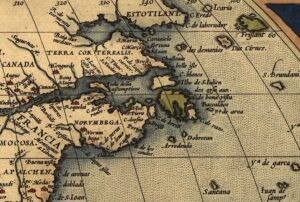Only 66,000 search results: Most are obscure genealogy websites and the odd blog post. I found myself a bit stumped as I tried to dig into this legendary Queen of Ireland. A few sites dedicated to the story of Tea Tephi came up, typically with old, early website designs and largely ignored by the wider public. Driven to find out more, I found myself going down some unexpected rabbit holes.
Who was she?
According to Irish poems (and a couple of websites), Tea Tephi was “the beautiful one with a royal prosperous smile” and “the most beautiful that traversed the Plain.” Supposedly, she was one of King Zedekiah of Judah’s daughters.
Zedekiah was the last King of Judah (of the House of David) before the Babylonian invasion by Nebuchadnezzar II in 597 BC. Zedekiah’s sons perished, but somehow his two daughters, Tea and Tamar Tephi, escaped with the prophet Jeremiah. They traveled from Egypt to Spain, Gibraltar, Cornwall and then ended up in Ireland.
According to legend, Tea Tephi brought sacred Hebrew relics to the British Isles, including the Ark of the Covenant and King David’s harp. She was also responsible for bringing the Stone of Destiny to Britain, which English and Scottish kings used for their coronations. The stone is called Jacob’s Pillow. It is supposedly the actual stone on which Jacob slept. King Edward I took it from Scotland to London.

The prophet Jeremiah. Painting: Michelangelo Buonarroti
Tea Tephi ended up marrying an Irish king named Heremon (also called Eochaidh). The royal couple gave birth to four children. The legend states that Tea Tephi was in fact the progenitor of the British monarchy.
British Israelism
It is a wild claim, right? But this claim formed the basis for a unique nationalist movement that arose in Britain in the 19th century. It was called British Israelism, the belief that Britain and its people descended from the Lost Tribes of Israel (i.e. the sons of Jacob). Through Tea Tephi, who was from the House of David, the British royal family had a historical and religious right to rule.
Chris Greyling of the University of Durban-Westville even stated that “there is a direct link between the British Empire or the British Commonwealth of Nations and the Kingdom of God.”

King David. Photo: Zvonimir Atletic/Shutterstock
The movement gained momentum with the writings of Scottish historian John Wilson. His book, called Our Israelitish Origin (1840), proposed that the Ten Lost Tribes of Israel scattered through Europe and Britain after the Neo-Assyrian Empire conquered Israel in the 8th century BC. According to Wilson, their descendants made it as far north as Scandinavia.
Other major proponents include Edward Hine, Edward Wheler Bird and Herbert Aldersmith. Together, they gave “evidence” for Europe’s ancient Israelite ties. This includes alleged linguistic links between the names of the tribes and places throughout Europe, as well as similarities in clothing, musical instruments and other cultural elements. Writer Edward Oliver points out the supposed link between Israelites and Scots. He claims that “the ancient Hebrews were also known to wear skirts or kilts whose woven plaids displayed the colors of their various tribes.”
This all sounds quite out there, which is why many call the movement pseudo- historical, pseudo-archaeological, or just downright false.
More questions?
However, I am still at a loss at to who Tea Tephi is. She was supposedly a beauty and daughter of a king but there is no information about her character and motivations. She seems to be in the background rather than the foreground. Additionally, there is no mention of her in any other ancient texts in Britain.

Queen Victoria. Photo: Bassano, 1882
Some believe that Tea Tephi was an invention of the British Israelism movement. The movement emerged during Queen Victoria’s reign. At this time, the monarchy was still unpopular with the people. Perhaps, the British Israelites wished to legitimize the British monarchy’s claims and importance by exploring their biblical heritage. Since it is a nationalist movement, it places emphasis on Britain’s status as a major world power (as it was at the time).
Chris Greyling highlighted the British Israel World Federation’s Annual Report in the 1930s which published essential “truths” about Britain. These truths included Britain as a “blessing to the world” and will never be defeated.
As for Tea Tephi, there was a queen named Tea in the Annals of the Kings of Ireland. She was the “daughter of Ludhaidh, son of Itha, whom Eremhon married in Spain.” Whether or not this is the same legendary queen remains unclear. Most likely, the British Israelism movement took this character and embellished her tale to help their cause.
Conclusion
It seems that Tea Tephi was merely a symbol for a movement spearheading British nationalist ideals. Most academics completely reject the idea of the Ten Tribes making their way to Europe. However, it does make an entertaining and fantastic thought experiment.






